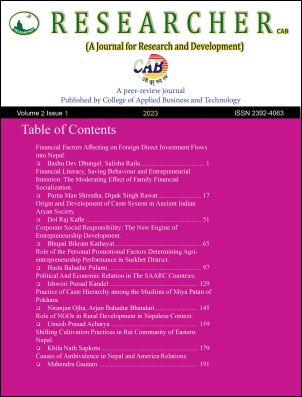Causes of Ambivalence in Nepal and America Relations
DOI:
https://doi.org/10.3126/rcab.v2i1.57651Keywords:
Ambivalence, bilateral relation, communism, decolonialAbstract
The United States of America and Nepal have worked together in many different fields after establishing bilateral diplomatic relations in 1947. The USA has been contributing to development sectors like infrastructure development. Still, there is a growing ambivalence among Nepali Youths, especially on the nature of their bilateral relationship. However, Nepal’s political parties have different perspectives on how America is engaged in Nepal. In 2022 Nepal ratified Millennium Challenge Corporation (MCC) from the parliament under fierce criticism and strong protests from some political parties, their sister wings, and even Civil Society Groups. Their protests were primarily concerned with the feeling that both countries have no equal status in the bilateral relationship. There are a few questions on the nature of American presence in Nepal. Nepal is a geopolitically significant land between two emerging nations of the world; India and China. There is a history of American interference in different countries of the world that has become a source of ambivalence in Nepal. Left wings politicians are very doubtful of the role of the USA in Nepal, especially how it showed desperation in turmoil to ratify the MCC project. This context has fuelled mistrust against the USA in Nepal. Though the majority of the youths of Nepal dream of going to America at any cost, they are still protesting against the American presence in the country. The attraction of Nepali youths to Diversity Visa applications and strong street protests against MCC are full of juxtapositions. Why this duality exists in the mind of Nepali youths? This article aims to study the causes of ambivalence in the relationship between the nations.
The United States of America and Nepal have worked together in many different fields after establishing bilateral diplomatic relations in 1947. The USA has been contributing to development sectors like infrastructure development. Still, there is a growing ambivalence among Nepali Youths, especially on the nature of their bilateral relationship. However, Nepal’s political parties have different perspectives on how America is engaged in Nepal. In 2022 Nepal ratified Millennium Challenge Corporation (MCC) from the parliament under fierce criticism and strong protests from some political parties, their sister wings, and even Civil Society Groups. Their protests were primarily concerned with the feeling that both countries have no equal status in the bilateral relationship. There are a few questions on the nature of American presence in Nepal. Nepal is a geopolitically significant land between two emerging nations of the world; India and China. There is a history of American interference in different countries of the world that has become a source of ambivalence in Nepal. Left wings politicians are very doubtful of the role of the USA in Nepal, especially how it showed desperation in turmoil to ratify the MCC project. This context has fuelled mistrust against the USA in Nepal. Though the majority of the youths of Nepal dream of going to America at any cost, they are still protesting against the American presence in the country. The attraction of Nepali youths to Diversity Visa applications and strong street protests against MCC are full of juxtapositions. Why this duality exists in the mind of Nepali youths? This article aims to study the causes of ambivalence in the relationship between the nations.




